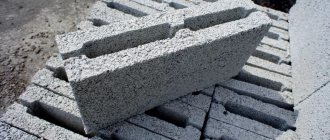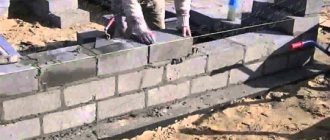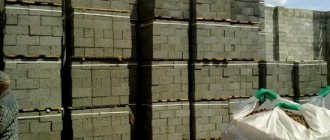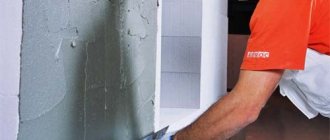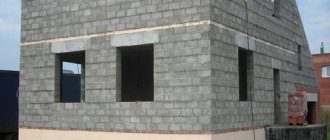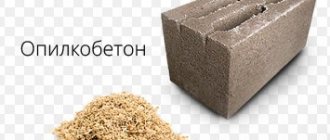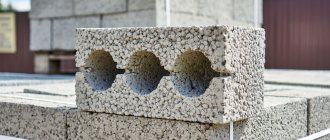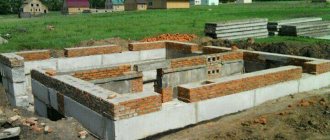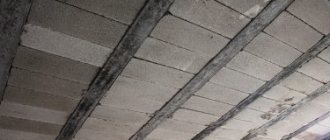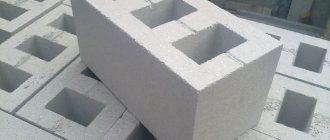Thermal capacity of expanded clay concrete blocks
The total thermal capacity of expanded clay concrete wall blocks.
What is coefficient “C”: (spec.) specific heat of expanded clay block (expanded clay cement blocks). How do these types of thermophysical characteristics of building stone differ, why is it impossible to get by with one physical parameter that describes the thermal properties of expanded clay concrete wall blocks, and why was it necessary to introduce the coefficient “to multiply entities, complicating the lives of normal people”? Not specific, but total thermal capacity, in the generally accepted physical sense, is the ability of a substance to heat up. At least that’s what any thermophysics textbook tells us - this is the classic definition of heat capacity
(correct wording).
This is actually an interesting physical feature. The “side of the coin” that is little familiar to us from everyday life. It turns out that when heat is supplied from the outside (heating, warming up), not all substances react equally to heat (thermal energy) and heat up differently. The ability of an expanded clay block
to receive, accept, retain and accumulate (accumulate) thermal energy
is called the heat capacity of an expanded clay block
.
And the heat capacity of expanded clay cement blocks
is a physical characteristic of a wall block, describing the thermophysical properties of building stone made of lightweight concrete with expanded clay filler.
At the same time, in different applied aspects, depending on the specific practical case, one thing may be important for us. For example: the ability of a substance to receive heat
or the ability to accumulate
thermal energy
or the “talent” to retain it.
However, despite some differences, in a physical sense, the properties we need will be described by the heat capacity of expanded clay cement blocks
.
A small but very “ugly snag” of fundamental nature is that the ability to heat up is the thermal capacity of expanded clay cement blocks
, is directly related not only to the chemical composition and molecular structure of a substance, but also to its quantity (weight, mass, volume).
Because of this “unpleasant” connection, the overall heat capacity of expanded clay-cement blocks
becomes too inconvenient a physical characteristic of wall blocks.
Since one measured parameter simultaneously describes “two different things”. Namely: it really characterizes the thermophysical properties of expanded clay block
, however, “in passing” it also takes into account its quantity. Forming a kind of integral characteristic, in which “high” thermophysics and a “banal” amount of substance (in our case: wall building stones made of expanded clay concrete) are automatically connected.
Well, why do we need such thermophysical characteristics of masonry blocks made of expanded clay concrete, which clearly show an “inadequate psyche”? From a physics point of view, the total heat capacity of expanded clay cement blocks
(in the most clumsy way), tries not only to describe the amount of thermal energy that can accumulate in a building stone made of expanded clay concrete, but also “to tell us along the way” about the amount of
expanded clay block
.
The result is absurdity, and not a clear, understandable, stable, correct thermophysical characteristic
.
Instead of a useful constant suitable for practical thermophysical calculations
, we are “slipped” to a floating parameter, which is the sum (integral) of the amount of heat received
by the expanded clay block
and its mass or the volume of concrete wall stones with expanded clay filler.
Thank you, of course, for such “enthusiasm,” but the amount of alcohol
I can measure it myself.
Having received the results in a much more convenient, “human” form.
I would like not to “extract”
the quantity of expanded clay cement blocks heat capacity of expanded clay cement blocks
at different temperatures, but to find out the weight (mass) in grams (g, g), kilograms (kg), tons (t), cubes (cubic meters, cubic meters, m3), liters (l) or milliliters (ml). Moreover, smart people have long come up with measuring instruments quite suitable for these purposes. For example: scales or other instruments.
The floating nature of the parameter is especially annoying: the total heat capacity of the expanded clay block
.
His unstable, changeable “mood”. When you change the “portion size or dose”, the heat capacity of the EXPANDED LIGHT BLOCK at different temperatures
immediately changes.
The greater the number of wall building stones, the physical size, the absolute value of the heat capacity of expanded clay cement blocks
increases.
The number of wall blocks made of expanded clay concrete is smaller, the value of the thermal capacity of expanded clay cement blocks
decreases.
It’s turning into something of a “disgrace”! In other words, what we “have” cannot in any way be considered a constant that describes the thermophysical characteristics of the EXPANDED LIGHT BLOCK at different temperatures
.
And we would like to “have” a clear, constant coefficient, a reference parameter characterizing the thermal properties
of building stone for masonry walls, without “references” to the number of wall blocks (weight, mass, volume). What to do?
Here a very simple, but “very scientific” method comes to our aid. It comes down to not only the bailiff “ud. – specific”
, before a physical quantity, but to an elegant solution that involves excluding the amount of matter from consideration.
Naturally, “inconvenient, unnecessary” parameters: the mass of the wall stone or the volume of the expanded clay block
cannot be excluded at all.
If only for the reason that if there is no number of expanded clay concrete blocks, then the “subject of discussion” itself will not remain. But there must be substance. Therefore, we choose some conditional standard for the mass of building stones or the volume of wall blocks, which can be considered a unit suitable for determining the value of the “C” coefficient we need. For the weight of an expanded clay block
, such a unit of mass of a wall block, convenient for practical use, turned out to be 1 kilogram (kg).
Now, we heat one kilogram of expanded clay block by 1 degree, and the amount of heat (thermal energy)
, which we need in order to heat the building stone made of expanded clay concrete by one degree - this is our correct physical parameter,
coefficient “C”
, which well, quite fully and clearly describes one of
the thermophysical properties of the expanded clay block at different temperatures
.
Please note that now we are dealing with a characteristic that describes the physical property of an expanded clay concrete wall block, but does not try to “additionally inform us” about its quantity. Comfortable? There are no words. It's a completely different matter. By the way, now we are no longer talking about the total thermal capacity of the expanded clay cement block
.
Everything has changed. THIS IS THE SPECIFIC HEAT CAPACITY OF THE EXPANDEDDZITE BLOCK
, which is sometimes called by another name.
How? Simply the MASS HEAT CAPACITY OF THE EXPANDED DIRECTION BLOCK
.
Specific (sp.) and mass (m.) - in this case: synonyms, they mean here the coefficient “C”
.
Table 1. Coefficient: specific heat of expanded clay block (spec.). Mass thermal capacity of expanded clay block, expanded clay cement block. Reference data building stones for laying walls: lightweight concrete blocks with expanded clay filler, wall blocks.
The amount of heat (thermal energy) required to heat a substance by 1 degree.
|
Expanded clay concrete blocks - thermal conductivity and applications
Construction organizations are increasingly using expanded clay concrete as a material for the construction of walls and internal partitions of residential buildings and outbuildings. Blocks made from this material are attractive due to their price-quality ratio. An important indicator is the thermal conductivity of expanded clay concrete blocks. This value is of great importance when constructing residential buildings in central Russia and northern regions, since the cold winter months require housing with low thermal conductivity of walls and ceilings.
Useful video
Below you can see a useful video on the construction of walls from expanded clay concrete blocks:
A bathhouse made of expanded clay concrete blocks is not necessarily additionally insulated. If the thickness of the expanded clay concrete bathhouse wall is 700 mm or more, you can plaster it and the house will be warm and the bathhouse will be quite effective. But a free-standing bathhouse building with walls made of expanded clay concrete blocks less than 0.7 m thick, as well as a bathhouse in a cold northern climate, requires additional thermal insulation. Briefly about expanded clay concrete blocks: this is a fairly traditional wall material that has some advantages over cinder blocks and brick materials. A filler made of expanded clay granules (foamed baked clay) serves as a coarse aggregate in the composition of expanded clay concrete, a fine aggregate is sand, and the binder is Portland cement. The blocks are molded and vibrated to produce an excellent and inexpensive wall building material with excellent thermal insulation properties, quite durable and yet lightweight. For more than half a century of use, expanded clay concrete has shown many advantages and confirmed one extremely unpleasant disadvantage - strong moisture absorption. Expanded clay blocks, unprotected from atmospheric moisture, absorb water, freeze and collapse in winter. Taking into account the fact that the walls of expanded clay concrete baths in the central zone of our country are usually built with a thickness of half a block, or 300 mm, and less often two blocks - a little more than half a meter, it is clear that one cannot do without thermal insulation in harsh winter conditions.
According to its technical characteristics, expanded clay concrete has a frost resistance of F50 (fifty cycles of alternating freezing and thawing without a significant decrease in quality). Without effective insulation and insulation of the walls, a bathhouse made of expanded clay concrete blocks with regular use will last no more than two to three years. But the advantages of such baths are significant enough to take care of thermal insulation: in terms of heat conservation, expanded clay concrete is three times warmer than brick, and two times lighter; complete environmental purity of expanded clay concrete at any temperature and humidity changes, complete absence of harmful emissions and toxins.
Types of expanded clay concrete
The building material includes cement, sand and expanded clay (granules of a light porous substance 3-20 mm, obtained by heating clay or shale). When constructing residential buildings, the construction norms SNiP 23-02-2003 “Thermal protection of buildings” are used in calculations of wall thickness and other indicators. Let's look at the main types of building blocks and their applications:
- Thermal insulation blocks (the material contains an increased amount of expanded clay, which makes it lightweight; expanded clay concrete of this type has low thermal conductivity, about 0.18-0.25 W/m*°C, with a density of 300-700 kg/m 3 ).
A material with good thermal insulation is effectively used in the construction of structures that require maintaining a stable temperature for as long as possible. This could be a bathhouse, a farm for growing mushrooms, a pigsty, warehouses where, on the contrary, it is necessary to maintain a lower temperature. Thermal insulation materials are also used to insulate existing walls and for partitions that do not serve as load-bearing structures in residential buildings.
- Structural thermal insulation blocks are durable, but have a higher thermal conductivity coefficient of expanded clay concrete. Indispensable when it is necessary to reduce the weight of a building structure in order to avoid severe ground settlement. This type of blocks is most popular in suburban construction, both for the construction of load-bearing walls and for internal partitions.
- Structural blocks are the most durable and heaviest (density 1800 kg/m 3 ). They are usually used for foundations and load-bearing walls, in the construction of industrial buildings, where structural strength is of great importance. When constructing buildings from durable expanded clay concrete, it is necessary to take into account the large weight of these blocks.
Based on their design features, the blocks are divided into:
- Hollow ones can have 2, 4, 7, 8 or more voids inside (solid or through), which significantly reduces weight, reduces the thermal conductivity of expanded clay concrete blocks and reduces the cost of the material.
- Solid ones do not have voids and are a more durable, but also expensive material.
Wall blocks have a thickness of 13.8; 19; 28.8 cm and weight 17-26 kg, partition products are thinner - 9 cm and weigh 7-15 kg.
Popular sizes of standard expanded clay concrete blocks
Characteristics of expanded clay concrete blocks.
Modern manufacturers of building materials have mastered a large number of different types of expanded clay blocks. But the most popular in construction today are products with dimensions of 390x190x90 mm and 390x190x188 mm.
Most often they are used in the construction of residential and industrial premises, as well as many civil engineering projects. With their help, both load-bearing walls and interior partitions are built.
The simplest calculation shows that in terms of its dimensions, one block with this porous aggregate is equal to the volume of approximately 6-7 ordinary clay bricks. Taking these parameters into account, we can say that the use of expanded clay concrete blocks not only speeds up the entire process, but also allows builders to save on masonry cement mortar, the consumption of which in this case is noticeably reduced.
Return to contents
What does thermal conductivity depend on?
The thermal conductivity and quality of concrete with expanded clay aggregate depends on the proportion of cement/sand/expanded clay, porosity, density, and brand of cement used. Secondary factors are the drying method, temperature and humidity of the environment.
On an industrial scale of production, the thermal conductivity of expanded clay concrete and its strength will depend on good drying and consolidation of the strength of the material. Typically, a stream of hot air or infrared radiation is used for drying. After processing the finished blocks, it takes about a month until they reach maximum strength.
It is recommended to use expanded clay concrete blocks in construction from large manufacturing plants, where professional equipment is installed for mixing components and casting blocks, and regulatory documents on product quality are also used.
Technical characteristics of expanded clay blocks
Expanded clay concrete blocks are used both in low-rise construction and in the construction of high-rise buildings, because their technical characteristics are ideally suited for these purposes. From these blocks you can build a building up to 12 floors high. The weight of the blocks ranges from 10 to 23 kg. The durability of expanded clay blocks can reach 60 years.
There are two types of blocks, differing in size and shape: wall and partition. According to the standards, their dimensions are: wall - 188x190x390 mm, partition - 188x90x390 mm. The maximum permissible deviation from standard dimensions should not be more than 10-20 mm. Another characteristic of this material is the presence of voids. The hollow kerazit block has vertical holes that reduce the weight of the block and increase its energy-saving qualities. Solid blocks are stronger, but also heavier.
Density and strength
These are the most important characteristics of expanded clay blocks, since energy-saving properties depend on density, and the reliability of building walls depends on strength.
The density of expanded clay block depends on the fraction and varies in the range from 500 to 1800 kg/m3.
The strength of the blocks is B3.5–B20; when converted to the value of the static load, it ranges from 35 to 250 kg/cm2.
Frost resistance and fire resistance
According to GOST, expanded clay blocks can have several frost resistance grades: F25, F35, F50 and F75. Brands of expanded clay blocks indicate the number of freezing and thawing cycles that a block completely saturated with water can withstand without loss of strength.
Expanded clay blocks have very good fire resistance. They have the highest fire safety class - A1. This means that when exposed to open fire, the wall does not collapse for 7–10 hours.
Coefficient of thermal conductivity
The thermal conductivity characteristics of building blocks are important when calculating the thickness of the walls of a building being constructed. It was experimentally found that the material reduces heat loss by up to 75%, which makes it possible not to build too thick walls. The thickness of the walls (L), m of the house being built will depend on the thermal conductivity coefficient (Kt), W/m*°C and the thermal resistance of expanded clay concrete, quantitatively designated by the heat transfer resistance coefficient (Rс), m 2 *°C/W: L = Kt* Rc The first value shows the ability of a body to transfer heat over a section of a certain length. The last value is determined in accordance with SNiP 02/23/2003 “Thermal protection of buildings” and depends on the humidity and climatic conditions of the region.
Table of thermal conductivity of expanded clay concrete blocks
Thermal conductivity data of the manufacturer, W/m*°C
| Density of blocks, kg/m 3 | Working thermal conductivity under building operating conditions, W/m*°С | |
| 0,12 | 500 | 0,16-0,2 |
| 0,2 | 800 | 0,25-0,3 |
| 0,35 | 1200 | 0,4-0,45 |
| 0,55 | 1600 | 0,65-0,7 |
| 0,65 | 1800 | 0,8-0,9 |
Effect of thermal conductivity
Scheme of a block made of expanded clay concrete. Before starting any construction work, you need to calculate the thermal conductivity coefficient, since it is of great importance for the durability of the structure. The resulting coefficient is necessary to calculate the thickness of walls made of expanded clay concrete blocks. Thermal conductivity is a characteristic of a material that indicates the ability to transfer heat from warm to cold objects.
In calculations, this characteristic of the material is shown through a certain coefficient, which takes into account the parameters of the objects between which heat exchange occurs, as well as the time and amount of heat. From the coefficient you can find out how much heat can be transferred in one hour from one object to another, while the size of the objects is 1m2 (area) by 1m2 (thickness). Different characteristics have different effects on the thermal conductivity of a particular material. These characteristics include: size, composition, type and presence of voids in the material. Thermal conductivity is also influenced by air temperature and humidity. For example, low thermal conductivity occurs in porous materials.
Thermal conductivity of expanded clay concrete blocks: is this indicator worthy of special attention?
Any building material intended primarily for the construction of walls has the property of thermal conductivity to a greater or lesser extent. This indicator will characterize the climatic conditions inside the building: heat exchange and humidity level.
One of the wall materials that meets the requirements of modern housing construction is expanded clay concrete. And the thermal conductivity of expanded clay concrete blocks is one of the most basic advantages of products made from this material. This important indicator will be discussed in this article.
Main technical characteristics of the material
Brief overview of expanded clay concrete blocks
Expanded clay concrete has currently gained high popularity among both builders and developers. This is due to high quality indicators and relatively low cost of products.
So what is this material?
As the name suggests, the main component that distinguishes expanded clay concrete blocks from similar products for construction is expanded clay. The material is light, inexpensive, and most importantly – durable and has the properties of heat and sound insulation.
In addition to expanded clay, the blocks contain cement, sand, water and organic impurities in the form of sawdust or ash. The brand of expanded clay and cement directly affects the characteristics of the future material and can vary from M100 to M500.
The production technology of expanded clay concrete blocks is quite simple, and in many ways similar to the production of blocks based on other materials. The finished mixture is placed in molds, dried and processed under high temperature.
Those who want to save money on construction can try making blocks from expanded clay concrete with their own hands. However, it is worth considering that the possibility of producing low-quality products increases significantly.
Classification of expanded clay concrete and scope of application
Depending on the proportions of the constituent materials, some differences in production processes and areas of application, expanded clay concrete is distinguished into three types:
Let's take a closer look:
- The first type of expanded clay concrete is used exclusively as thermal insulation. Such a block is light in weight and low in density, but its thermal insulation or temperature exchange properties are much higher than those of most materials. As can be seen in the photo, the heat-insulating block is externally distinguished by particularly pronounced porosity.
- The second type has greater density and thermal conductivity, due to this the strength indicators increase, but the property of temperature transfer is significantly reduced. This type of block is used as a material for the construction of partitions and internal walls.
- The third type , structural, has the highest density. It can be used as a facing wall material, for the construction of partitions for the purpose of sound insulation and external walls of low-rise buildings. Such blocks are often used as one of the components of load-bearing structures in the construction of various engineering structures. For example, a bridge. Sometimes used as an alternative to curb stones. Can also serve as a support for a bench.
Note! Each of these types of expanded clay concrete blocks has its own advantages and disadvantages - and here you have to make a choice: either thermal conductivity or strength suffers. But with the right approach, this may not affect the future building. For example, thermal insulation blocks with the lowest density are perfect for building a bathhouse, for which heat retention is most important. But when building a two-story house, it is better to give preference to denser products.
Composition, density and thermal conductivity of expanded clay concrete
The characteristics of expanded clay concrete are determined by its composition - it is produced on the basis of cement, quartz sand and lightweight expanded clay aggregate. The presence of porous coarse-grained expanded clay material in the composition of this concrete causes a decrease in its specific gravity, in comparison with classic heavy concrete. A structure made of expanded clay concrete of the same volume will be 30% lighter in comparison with a similar structure made of concrete on crushed stone or gravel with the same strength grade.
Classification
Depending on the intended purpose, there are three types of expanded clay concrete: thermal insulation, thermal insulation-structural and structural. The first is designed for use for thermal insulation tasks, and the last is for the manufacture of load-bearing structures of various grades of strength. Thermal insulating concrete on expanded clay gravel has a specific gravity of 350 to 400 kg/m³ and is limited by compressive strength to 10 kgf/cm².
The thermal insulation and structural design is capable of withstanding loads of up to 75 kgf/cm² with a volumetric weight ranging between 700 and 1400 kg/m³. The thermal conductivity of this material can reach 0.5 kcal/m·h·°С, which is already inferior to thermal insulation, for which this figure can reach 0.2 kcal/m·h·°С. Thus, the pattern becomes clear that as the strength of expanded clay concrete increases, it loses its thermal insulation characteristics.
The density of expanded clay concrete for structural purposes makes it a good alternative to heavy concrete when creating various complex structures that bear significant loads. This indicator can reach a value of 1700 kg/m³ for material grade M400, which is characterized by a strength of 400 kgf/cm².
Thermal conductivity as one of the most important properties of wall masonry materials
Thermal conductivity, as a physical property of an object, is the ability of a material to give off heat. The thermal conductivity coefficient indicates at what speed and in what volume energy is transferred from a warmer object to a cold one in one hour, over an area of 1 m2 at the base and 1 meter thick.
Thermal conductivity indicators
To put it simply, the thermal conductivity coefficient of expanded clay concrete blocks is responsible for the ability to maintain the temperature inside the building - and the higher this indicator, the faster the building will heat up or cool down.
Let's figure out what influences the quantitative value of the coefficient? There are a number of factors that have a direct impact on the heat transfer ability of the walls of a future home.
These include:
- Block porosity. This indicator is influenced by the amount of expanded clay and its fraction. The more pores, the less weight and density, which in turn affects thermal conductivity.
- Block size and voidness
- Source material: ratio of proportions and brand.
Let's look at all this in table form in more detail: The dependence of the thermal conductivity of a block on its density.
| Thermal conductivity of expanded clay concrete W/(m °C) factory indicator | Thermal conductivity index under operating conditions W/(m °C) | Density indicator |
| 0,12 | 0,15-0,2 | 500 kg/m3 |
| 0,15 | 0,20-0,26 | 600 kg/m3 |
| 0,20 | 0,25-0,30 | 800 kg/m3 |
| 0,25 | 0,3-0,4 | 1000 kg/m3 |
| 0,35 | 0,4-0,5 | 1200 kg/m3 |
| 0,45 | 0,55-0,65 | 1400 kg/m3 |
| 0,55 | 0,7-0,8 | 1600 kg/m3 |
| 0,65 | 0,82-0,9 | 1800 kg/m3 |
Table 2. Brief instructions on material consumption when preparing a mixture for expanded clay concrete blocks of different densities.
| Cement M400 | Density of expanded clay, kg/m3 | Amount of expanded clay, m3 | Water, l | Sand, kg | Density of expanded clay concrete |
| 250 | 700 | 1,0 | 140 | — | 1000 |
| 430 | 700 | 0,8 | 140 | 420 | 1500 |
| 430 | 600 | 0,68 | 140 | 680 | 1600 |
| 400 | 700 | 0,72 | 140 | 640 | 1600 |
| 410 | 600 | 0,56 | 140 | 880 | 1700 |
| 380 | 700 | 0,62 | 140 | 830 | 1700 |
Table 3. Voids and its effect on the properties and mass of the block
Block typeVoidness, %Thermal conductivityWeight400.19-0.2711-14
400,19-0,2711-14
400,19-0,2711-14
400.19-0.2711-14 In addition to heat exchange, expanded clay concrete blocks have the ability to control the level of humidity in the room: when this value increases, moisture is absorbed, and when a dry microclimate predominates, moisture is released, thus establishing the most comfortable living conditions.
Characteristics of wood concrete
This is a type of lightweight concrete consisting of 80-90% organic matter, chemical additives, water and cement. The main raw materials can be crushed wood chips, flax or hemp kernels, crushed cotton stalks or rice straw. This component is otherwise called wood concrete.
It appeared back in the 30s of the 20th century in Holland. Due to its environmental friendliness, heat-saving and sound-proofing properties, the building material has become widespread in the USA, Canada and European countries.
The combination of wood waste and cement mortar makes the wood concrete block a unique composition characterized by the properties of these two components
. And in order to increase the level of adhesion of wood and cement, mineralization is necessary.
This process involves chemical additives such as aluminum sulfate, calcium chloride and nitrate, and liquid glass. Thus, the influence of organic matter on concrete hardening is neutralized.
Arbolite has an excellent thermal conductivity (0.08 - 0.17 W/m K) and good density (400 - 850). Strength is evidenced by high frost resistance (25-50 cycles) and resistance to shrinkage (0.4-0.5). Such properties guarantee a long service life of the structure. The material also has good fire resistance and noise absorption (0.17-0.6). It has excellent compressive strength (0.35 - 3.5 MPa), bending strength (0.7 - 1.0 MPa) and high moisture absorption (up to 40-85%).
Thermal insulation boards and mixtures for pouring are made from wood concrete. But the most popular product is blocks.
They are produced in standard sizes 500 x 300 x 200 mm. The material is used for the construction of walls of low-rise buildings (up to 3 floors). According to the manufacturer, one layer of wood concrete foam blocks is quite enough to retain heat.
Thermal capacity of expanded clay concrete blocks
The thermal conductivity coefficient of expanded clay concrete blocks appears in the formula that determines the required standard wall thickness for the future structure. The thickness is calculated as follows: the heat transfer resistance index (δ) is multiplied by the thermal conductivity value (Rreg).
Let's say the resistance value is 2.9 cm²×°C/W, and the thermal conductivity KBB (λ) is 0.4 W/m×°C. In this case, to calculate the wall thickness you need to multiply these indicators:
Let's look at several methods of insulation and try to understand which one will allow you to retain heat inside the room as efficiently as possible.
Let's say the interior decoration of the rooms is done using plasterboard on a metal profile. A fairly common mistake is that many unprofessional builders simply cover the walls with plasterboard and believe that this will be enough for a comfortable stay in the house throughout the year.
However, this self-deception begins to dissipate with the onset of the first cold weather: “chronic” drafts are to blame. Of course, everything depends on the hollowness, density and composition of the blocks (as discussed earlier), but in most cases it is necessary to take appropriate insulation measures. Since condensation forms on the drywall on the outside, the wall begins to become damp and mold inevitably “settles” in it.
You can get rid of such troubles by simply covering the outside of the wall with plaster. During this event, there is no need to rush; you need to plaster with high quality and try not to leave any gaps. You should not pay much attention to the aesthetic aspect, since subsequently the wall can be decorated with facing material. This approach will allow you to reliably protect yourself from drafts. However, in this case, another physical process called “convection” begins to affect the wall. The presence of pores in the wall allows air to circulate within it. As you know, warm air always accumulates at the top, and cold air at the bottom. Warm air collected under the ceiling, cooling, moves along the outside of the wall, in other words, along the outer layer of plaster, falls down and returns to the room under the cladding of the house.
Another option is plastering from the inside. That is, instead of drywall inside the premises, a layer of plaster is applied to the walls, which, in theory, should protect against drafts. But in this situation, the positive effect of the coating is much lower, because in the absence of plaster on the outer part of the wall, cold air continues to enter the room from the street. Cold air penetrates deep into the wall, where it is stopped by a layer of plaster, but at the same time it takes heat from the wall, in accordance with the laws of physics, rises up and goes outside, since the path into the room is blocked by the plaster coating. This way the wall cools down.
There is another scenario: the wall is plastered from the inside, and siding with insulation is installed on the outside. It may seem that this solution is the most optimal, but in fact, siding with insulation is ventilated quite well. Therefore, exactly the same air exchange occurs as was described in the previous situation, and the wall loses its temperature.
If you plaster the wall on both sides, inside and outside, the situation will change dramatically. In this case, the wall is a kind of thermos that perfectly retains heat.
Many people choose expanded clay concrete blocks for building a bathhouse. Everything is the same here. To retain maximum heat in the steam room, it is necessary to cover the wall with a layer of plaster both from the outside and from the inside, otherwise it will also give off its temperature. That is, simply decorating the inside of the room with clapboard is not enough. Even simply rubbing the outside of the wall with cement mortar can achieve a positive effect. Laminated blocks, on which a special coating has previously been applied, look more aesthetically pleasing. Such blocks do not require additional plastering and have all the properties to retain heat indoors.
Let's compare expanded clay block with gas block and foam block
Aerated concrete blocks quickly collapse under the influence of water, which cannot be said about expanded clay concrete blocks. And if we compare the foam block and expanded clay block, then the first, in addition to the above, also has a severely disrupted geometry. Expanded clay concrete blocks, foam blocks and aerated concrete blocks are quite similar in a number of characteristics. Expanded clay blocks absorb less moisture and are also superior in strength to their competitors. Another important characteristic is the thermal conductivity of the expanded clay block, on which the preservation of heat in the room depends.
| Characteristics | Expanded clay blocks | Gas blocks | Foam blocks |
| Strength (kg/cm2) | 25-150 | 10-40 | 10-60 |
| Density (kg/m3) | 500-1800 | 200-900 | 450-900 |
| Thermal conductivity (W/mdegree) | 0.15-0.45 | 0.10-0.30 | 0.10-0.40 |
| Frost resistance (cycles) | 15-50 | 15-35 | 15-50 |
| Water absorption (%) | 50 | 95 | 85 |
